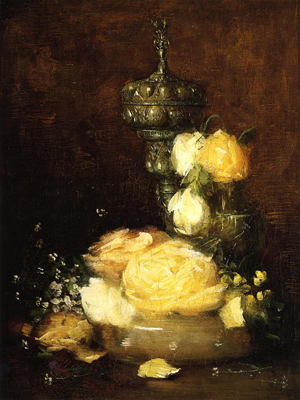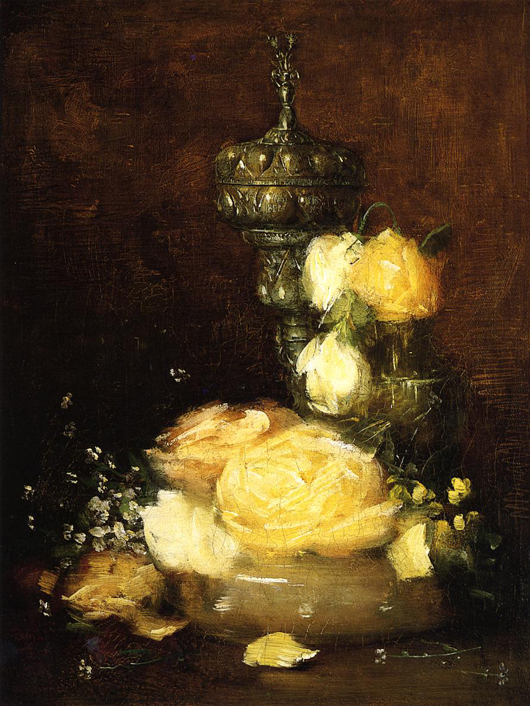
PROVO, Utah (AP) – The painting simply vanished.
A beautiful oil and canvas painted by the hand of an American master, it was stolen sometime between 1970 and 1985.
Once a persistent detective determined it was missing, it was too late to know whether it had once graced a cultured professor’s wall or waited patiently in a corner for the day it would be showcased to the masses.
Certainly no one could say who took it. And to this day, nobody knows how The Silver Chalice with Roses slipped into the shadows of the art world’s international black market.
At least nobody is telling.
The Silver Chalice made its way through the hands of a local crook, art dealers in Park City, Denver and New York—one of whom is in prison for murdering a model—and a Swiss baron.
It’s a story that took BYU detectives years to unravel.
You could say it all started around 1959.
Mahonri Young was only two years in his grave. His estate, combined with his deceased wife Dorothy’s, boasted nearly 10,000 works of art—a collection that would make any art connoisseur weak at the knees.
After the couple’s deaths, heirs of the estate decided to bestow the art treasury to one lucky recipient: Brigham Young University. Perhaps this transaction was appropriate because Young happened to be the grandson of the school’s namesake.
BYU didn’t have a museum then, so where did the 9,903 art pieces in the Young collection go?
For an amateur in the art game, BYU’s answer was storage rooms, with the occasional piece making its way to a faculty member’s wall.
And in this game, BYU certainly got played.
For the next 15 years pieces of artwork disappeared, and no one noticed their departure via shadowy transactions shrouded in secrecy.
It wasn’t until 1986 that a light was shined on years of deceit. BYU Police Lt. Arnie Lemmon decided to investigate the years of ongoing rumors of fraud and thievery within the BYU art department. He went into the case focusing on certain bronze works said to be fakes. What he uncovered turned out to be more than just a couple forgeries—between $4 million and $6 million dollars in art works had vanished.
BYU isn’t one to let go of valuable items easily, and the ongoing search turned into decades of detective work.
Lemmon took a special interest in this particular case. His work began with informing the art world that there were stolen pieces floating around. Lemmon registered about 250 missing pieces with the International Foundation for Art Research, the world’s largest database of missing art. The foundation keeps its finger on the pulse of any clues that might surface concerning the missing hoard.
Thus far the international art theft detectives have aided in the recovery of about 45 paintings, most recently the oil and canvas Silver Chalice with Roses, painted by Dorothy’s father, J. Alden Weir. But why does this painting, one barely larger than a piece of printer paper, get special mention?
After being stolen sometime between 1970 and 1985, Silver Chalice with Roses resurfaced in 1987. It was listed in an art catalogue produced by art collector and artist Barbara Novack. The issue was used to showcase the extensive works owned by a wealthy collector in Switzerland. The magazine listed the provenance of the piece. Right at the top of the listing was Brigham Young University. Unbeknownst to the current handler, a Swiss count named Baron Hans Heinrich Thyssen-Bornemisza, the Silver Chalice was stolen from BYU.
On June 13, 1987, Lemmon sent a letter politely asking the baron to return the painting to Brigham Young University, explaining the situation.
The baron’s estate not so politely declined. He didn’t like hearing his money was ill spent.
“It went on hold after that because they were very adamant that they would not return it,” Lemmon said.
Despite the estate’s unwavering stance, Lemmon began to work feverishly on the case.
“The challenge then became, we have to prove how it was originally in our art collection,” Lemmon said. The goal was to fill in the missing pieces on the provenance, so if a trial became necessary, the task force could subpoena each person who had owned and sold the work of art.
Lemmon pulled the file. He found a couple of pieces of information to work with to begin tracing the provenance. First, this piece was part of the Mahonri Mackintosh Young collection donated to the school. Second, there was a photo on file of the painting, which helped prove BYU did in fact have the art piece at some point in time. Third, Lemmon navigated through countless minutes of acquisition committee meetings to be sure the painting was never authorized to be sold. It wasn’t.
With these facts in hand, Lemmon began to work backward from the baron to find the original source of the thievery.
He found out the baron bought it from an art dealer in New York, a man by the name of Andrew Crispo. However, Crispo was unavailable because he was incarcerated at a New York penitentiary for murdering a model. Lemmon had to communicate with the man through Crispo’s attorney.
Lemmon said he was lucky because Crispo didn’t like the man he bought it from. Shortly after initial contact, Lemmon received a handwritten note from Crispo with the name of the man who sold Silver Chalice with Roses to him, Ira Spanierman. This was a familiar name to Lemmon, because Spanierman also handled several sales that Lemmon was tracking at the time. Spanierman said he bought the painting from New York art dealer Terry DeLapp. Lemmon interviewed DeLapp and found him fairly cooperative. DeLapp gave Lemmon reason to look back west with word that DeLapp purchased it from an art dealer in Denver, Colo., Fred Rosenstock.
Rosenstock provided Lemmon with a critical piece of information. He had purchased it from a man named Dan Olsen. Olsen lived in Park City, Utah, and owned a gallery in Salt Lake City. He turned out to be a major player in many of the missing art pieces.
“The only part we were never able to put together is how Dan got his hands on it from the beginning,” Lemmon said. “We pretty well assume we know how, but we never could really directly confirm.”
Lemmon declined mentioning the specifics on his theories. But Lemmon believes Olsen possessed it at some point, because he interviewed several witnesses who said they saw it hanging in Olsen’s house. Olsen has since died, taking his secrets with him.
Olsen’s involvement aside, Lemmon had finally gathered enough information to continue negotiations with the baron.
Though the puzzle was coming together, communication with Baron Thyssen-Bornemisza didn’t go well. Lemmon said that at that time, art recovery was not the same as having a car stolen, where police would just seize it and return it. There wasn’t really a process to recover the painting, and it was especially tricky because the baron thought he bought the painting in good faith. Since it was listed as stolen, it also barred the baron from selling the painting until the case was solved.
At one point, Lemmon actually sat down with the baron’s attorney and went through the case and “just appealed to his ethics.” The baron’s attorney wouldn’t budge.
Lemmon wouldn’t either.
“We made it known in the art world that we will never relinquish titles (to these paintings),” Lemmon said.
Meanwhile, Silver Chalice with Roses impressed itself upon minds across the country.
“It’s a lovely still life,” said Marian Wardle, curator of American art at BYU’s Museum of Art and an expert on Weir. “It was a transitional period for Julian Alden Weir, who was a very academic painter. These floral still lifes, I think, helped loosen up his brush, and he became a leader of the American impressionist painters. That is what he is known for.”
He painted Silver Chalice with Roses, for his fiancée Anna Dwight Baker, one of his former students. For her birthday, he presented her the painting, which is inscribed on the chalice “J. Alden Weir to Anna Dwight Baker” and dated May 18, 1882. The painting was passed on to their daughter, Dorothy Weir, who married Mahonri Young. Weir predeceased her husband, Young, and when he died, his heirs brought his collection to BYU.
No one knows exactly were the Silver Chalice was stored when it came to BYU, and then it disappeared.
Then it was found again, but remained out of BYU’s reach. “Legal wheels move slowly, that’s the reason,” Wardle said.
To keep up with the investigation, Lemmon periodically sent a letter requesting the painting’s return. The baron died in 2002, and BYU’s attorney reintroduced himself to the estate’s attorney. The negotiations intensified in 2009. For about a year and a half they negotiated back and forth to reach an agreement, and finally they came to a decision. The attorney for the estate had an independent appraiser assess the painting’s current market value, and BYU would pay for half the appraised value.
Though the amount was undisclosed, Lemmon said the painting was valued at auction in 2002 at $60,000 to $80,000.
The purchase brought decades of investigative work to an end.
“It was really gratifying to get it back,” Lemmon said. “It also sends the message to the art world that we aren’t just going to roll over what else is out there that is ours. If we find it, and we have enough of a case file on it to prove that it belongs to us, then we will go after it.”
The painting arrived home last month dressed to the nines in special packaging, late for an ongoing art show at BYU’s Museum of Art called “The Weir Family 1820-1920: Expanding the Traditions of American Art.” A sticker labeling it property of Brigham Young University still clings to the back of the frame. It is hanging between two other paintings, another by J. Alden Weir and one by his brother John Ferguson Weir.
There are about 800 pieces still missing, and Lemmon said most were laundered in Europe. Hopes are dim to ever recover many, but what the task force does find it will pursue.
Each return, for him, is a victory.
“The bottom line for me is that it’s kind of like getting one of your lost kids back,” Lemmon said.
___
Information from: Deseret News, http://www.deseretnews.com
Copyright 2012 Associated Press. All rights reserved. This material may not be published, broadcast, rewritten, or redistributed.
AP-WF-02-29-12 2217GMT
ADDITIONAL IMAGE OF NOTE


